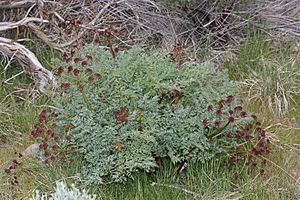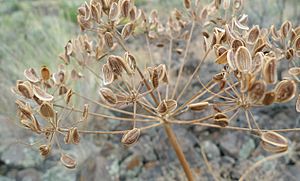Fernleaf biscuitroot facts for kids
Quick facts for kids Fernleaf biscuitroot |
|
|---|---|
 |
|
| Lomatium dissectum in Wenas Wildlife Area | |
| Scientific classification | |
| Kingdom: | |
| (unranked): | |
| (unranked): | |
| (unranked): | |
| Order: | |
| Family: | |
| Tribe: |
Selineae
|
| Genus: | |
| Species: |
L. dissectum
|
| Binomial name | |
| Lomatium dissectum |
|
The fernleaf biscuitroot, also known as Lomatium dissectum, is a fascinating wild plant. It belongs to the carrot family, just like the carrots you might eat! This plant grows naturally in many parts of western North America.
Meet the Fernleaf Biscuitroot
The fernleaf biscuitroot is a tall plant that can grow up to 1.4 meters (about 4.5 feet) high. It grows from a thick main root called a taproot. Most of its leaves grow near the bottom of the plant. These leaves are large and divided into many small, narrow parts, making them look like fern leaves.
Where It Grows
This plant is native to a large area in western North America. You can find it in different places, from mountains to valleys. It grows on the eastern slopes of the Cascade Range and in the Rocky Mountains. It is also found in the Klamath Mountains, the eastern Transverse Ranges, and the Sierra Nevada in California.
What It Looks Like
The fernleaf biscuitroot produces clusters of small flowers. These flowers can be yellow or reddish in color. They grow in a shape called an umbel, which looks like an umbrella. Each flower cluster sits on a stalk up to 10 centimeters long. After the flowers, the plant makes fruits that look a bit like pumpkin seeds.
There are two main types, or varieties, of fernleaf biscuitroot. Both types can have either yellow or purple flowers. You can tell them apart by looking at the stalks on their fruits. One type has longer stalks, and the other has shorter ones.
Special Uses
Scientists have studied the fernleaf biscuitroot for its special properties. Extracts from its root have shown promise in fighting certain germs. For example, it has been studied for its ability to stop the effects of rotavirus. It has also shown activity against some types of bacteria, including those that cause diseases like tuberculosis.



